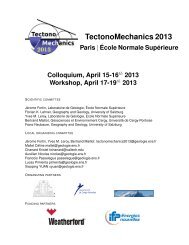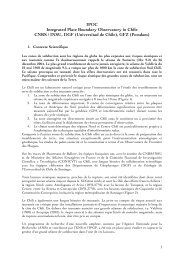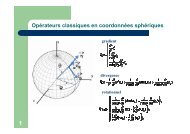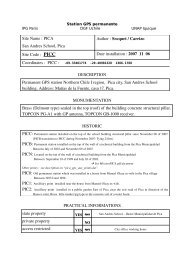PDF file - Laboratoire de Géologie de l'Ecole normale supérieure - Ens
PDF file - Laboratoire de Géologie de l'Ecole normale supérieure - Ens
PDF file - Laboratoire de Géologie de l'Ecole normale supérieure - Ens
Create successful ePaper yourself
Turn your PDF publications into a flip-book with our unique Google optimized e-Paper software.
X - 6 SIMONS ET AL.: GPS MEASUREMENTS IN S.E. ASIA TO REFINE SUNDALAND MOTION<br />
sub-networks, conform to Table 1. For the campaign style observations,<br />
most position outliers were due to seismic events, especially<br />
in the Sulawesi region. The residuals are well within the range of<br />
absolute accuracy indication given in the previous section. All of<br />
the sites use a fixed antenna-setup, with the exception of the BAKO<br />
monuments in Sulawesi, which were observed using tripods. Many<br />
of these sites have poorer visibility and are located in/near <strong>de</strong>formation<br />
zones, and therefore the residuals at these sites are slightly<br />
higher w.r.t. to the linear trend fitted.<br />
For the IGS sites used in the mapping, the residuals will be almost<br />
i<strong>de</strong>ntical to the ones of Table 3 (they were projected onto<br />
their ITRF-2000 positions at each epoch, and only the weighting is<br />
slightly different in the velocity estimation step). It is interesting to<br />
look at the IGS sites in and near S.E. Asia that were not inclu<strong>de</strong>d<br />
in the mapping, shown in Table 5. This gives another indication<br />
on the quality of the mapping. In<strong>de</strong>ed, the IGS stations in Table 5,<br />
located in and around the S.E. Asia network show good linear fits<br />
with few outliers, and their performance is similar to that of other<br />
regional and global sites. Only PIMO performs less well, caused<br />
by the receiver problems due to the increased solar activity around<br />
2000.<br />
To illustrate the velocity estimation process, the result for MASS<br />
station KUAL is shown in Figure 3, and <strong>de</strong>monstrates the robustness<br />
and accuracy of the GPS data analysis presented here. Station<br />
Table 6. Differences Obtained/ITRF-2000 IGS Station Velocities.<br />
Shown are the velocity differences after subtracting the<br />
ITRF-2000 velocity values from the ones estimated in this paper.<br />
The top part is for IGS stations used in the mapping process,<br />
while the bottom part is for IGS sites that were projected onto the<br />
ITRF-2000 along with the S.E. Asia sites. In the remark section,<br />
important events in the analyzed time series are given, and also<br />
if a position jump was estimated during the linear trend fitting.<br />
IGS Velocity differences (mm/yr) Remarks<br />
Station North East Up<br />
Used<br />
ALGO -0.1 -0.1 -0.5<br />
COCO 0.8 -0.6 0.4 before seismic event<br />
FAIR -0.6 -0.3 2.0 seismic event / jump<br />
GOLD 0.9 1.9 -6.2 seismic event / jump<br />
GUAM -0.1 0.4 1.5 unknown event / jump<br />
IISC -0.1 -0.3 0.1<br />
KERG 0.9 0.2 2.8<br />
KIT3 0.3 0.2 -1.7<br />
KOKB -0.1 0.8 -1.1 antenna event / jump<br />
KOSG -0.6 -0.6 1.6 antenna event / jump<br />
KWJ1 -0.2 0.8 0.6<br />
LHAS -0.3 1.7 2.7 relative new / noise<br />
MAC1 -0.9 0.1 -2.4<br />
MAS1 0.5 0.3 1.3<br />
ONSA -0.7 -0.3 2.1<br />
PERT 0.4 -0.1 3.3<br />
TIDB 0.8 0.9 -4.7<br />
TSKB -1.0 -0.1 -0.3 antenna event / jump<br />
VILL 0.3 -0.2 1.5<br />
WUHN -0.6 -0.7 -0.9<br />
YAR1 -0.2 -0.3 -4.4<br />
YELL 0.5 -0.4 0.6<br />
Average 0.0 0.2 -0.1<br />
RMS 0.6 0.7 2.5<br />
Not used<br />
BAKO 2.2 0.8 -8.1 improved wrt ITRF-2000<br />
NTUS 3.7 0.3 0.7 improved wrt ITRF-2000<br />
PIMO 29.1 -17.3 3.9 wrong in ITRF-2000<br />
MKEA -0.4 0.1 -0.1 validation site<br />
KARR 0.9 -0.5 2.8 validation site<br />
SHAO -0.5 -0.1 -4.5 validation site<br />
KUNM -0.5 0.5 5.3 validation site<br />
DARW 2.9 -1.3 10.0 improved wrt ITRF-2000<br />
XIAN -2.1 0.1 -2.3 new and few data<br />
KUAL initially was a GEODYSSEA site, which was equipped with<br />
a permanent receiver by DSMM at the end of 1998. One outlier<br />
can be clearly noticed, for the 1997 measurement, due to a different<br />
antenna used and/or a misalignment of the antenna setup. The<br />
error estimates are 1-values, as they come out of the GPS data<br />
analysis. The time series for the complete network are given at<br />
http://www.<strong>de</strong>os.tu<strong>de</strong>lft.nl/˜wims/sunda.html<br />
In or<strong>de</strong>r to get more grip on the accuracy of the station velocities,<br />
the obtained velocities for the IGS sites can be compared with<br />
their velocities in ITRF-2000. The results are shown in Table 6. It<br />
should be pointed out that in the GPS data analysis, the IGS sites<br />
were nowhere constrained to both their ITRF-2000 positions and velocities.<br />
The inclu<strong>de</strong>d IGS sub-network was only projected onto its<br />
predicted positions using the ITRF-2000 for each campaign/weekly<br />
averaged solution. Table 6 confirms that the mapping strategy was<br />
stable throughout the time period the data was analyzed for. The<br />
Figure 4. S.E. Asia 1994-2003 Velocities in ITRF-2000. The<br />
error elipses are 3-values, and also the sites consi<strong>de</strong>red to be<br />
located on rigid Sundaland are shown (open black dots).<br />
Figure 5. Velocity residuals Sundaland sites w.r.t pole. The velocity<br />
residuals are shown for both the (28) sites that are located<br />
on rigid Sundaland (black dots) and the sites (19) that are located<br />
in <strong>de</strong>formation zones near the Sundaland boundaries (red<br />
crosses). The circle is drawn with a 3 mm/yr radius, which was<br />
the treshold value to accept sites on rigid Sundaland.






